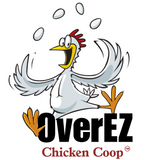When it comes to chicken coops, most people focus on the fun stuff—how many hens can fit, where to put the nesting boxes, what color to paint it (we see you, Pinterest board).
But there’s one less glamorous feature that literally makes or breaks a healthy flock:
👉 Ventilation.
Yep—airflow. The invisible hero of chicken keeping.
So before you start designing your dream henhouse or buying that adorable “Welcome to the Coop” sign, let’s talk about why good ventilation isn’t optional—it’s absolutely eggs-essential.
💨 What Is Coop Ventilation, Really?
Ventilation is just a fancy word for fresh air coming in and stale air getting out.
Inside your coop, your chickens are breathing, pooping, flapping, and (if we’re being honest) throwing tiny feathered raves at 5 a.m. All of that builds up moisture, ammonia, and heat.
Without proper airflow, your coop becomes:
-
Damp 🫠
-
Smelly 😷
-
A perfect environment for respiratory issues, frostbite, mold, and mites 🙅♀️
Basically, if your coop smells like a gym locker on a humid day, you’ve got a ventilation problem.
🐔 Why Chickens Need Fresh Air (Even in Winter!)
We get it—you want to keep your chickens warm in the winter. That’s natural. But sealing up every crack and crevice is a recipe for disaster.
Here’s the truth:
-
Chickens handle cold better than moisture.
-
A damp coop causes frostbite faster than cold temps alone.
-
And that ammonia smell? It doesn’t just stink—it damages their lungs.
Think of it like this: would you rather wear a coat in the fresh air, or be trapped in a musty bathroom with no window? Yeah. Same.
🛠️ What Good Ventilation Looks Like
You don’t need high-tech fans or a chicken HVAC system. Here’s what matters most:
1. High Vents = Happy Hens
Ventilation should happen up high—above roost level—so air can escape without creating a draft on your sleeping ladies.
Bonus points if your coop has built-in roofline ventilation like every OverEZ Chicken Coop (we’ve got you covered—literally).
2. Crossflow is Key
Fresh air should be able to come in from one side and move across the coop to exit on the other side. Think gentle breeze, not wind tunnel.
3. Openings with Hardware Cloth
Windows, vent slats, and gables should be covered in ½" hardware cloth to keep out raccoons, snakes, and other uninvited guests.
Chicken wire keeps chickens in. Hardware cloth keeps predators out.
🏖️ Summer vs. ❄️ Winter Ventilation
In Summer:
-
Open every window and vent you can.
-
Add shade around the coop to keep things cool.
-
Your coop should feel breezy, not stuffy.
In Winter:
-
Keep upper vents open to release warm, moist air.
-
Block lower drafts (like around doors or floor gaps).
-
Don’t trap heat at the cost of air quality—your hens will thank you.
🧼 Bonus Tip: Ventilation Helps With Odor and Cleanliness
Nobody likes a stinky coop—not you, not your chickens, and definitely not your neighbors.
Good airflow keeps bedding drier, poop smell lower, and bacteria growth way down.
Pro Tip: Pair great ventilation with deep litter method or regular cleanouts and you’ll be living the sweet-smelling chicken life.
🔧 Built-In Ventilation, the OverEZ Way
We designed OverEZ Chicken Coops with ventilation in mind from the start:
-
Gable vents that promote airflow year-round
-
Large windows that open for easy access and fresh breezes
-
Tight construction that blocks drafts, but not the air chickens need
Basically, we thought of it so you don’t have to. 🙌
🎉 Final Cluck: Breathe Easy
At the end of the day, your chickens rely on you to give them a clean, safe, and comfortable place to live.
And while ventilation might not be the flashiest part of your coop, it’s one of the most important.
So give your flock the gift of fresh air—because nothing says “I love you” like a breeze in the beak. 🐓💨
Want help picking a well-ventilated coop that’s built to last?
OverEZ Chicken Coop has you (and your chickens) covered—literally and figuratively.

